
Features
A scandal in Scandinavia
The first time Rick Wright was thrown out
I'd like to tell the story of the first time Rick Wright was thrown out. No, not that other (more widely-known) time he was thrown out. This pertains explicitly to that time in 1967, that "first time", when Rick Wright was thrown out (and beaten up). Or, more precisely, beaten up and then thrown out.
 Rick Wright in Copenhagen 1967, "Can't they tell when one is happy?"
|
It all happened during that fateful Scandinavian tour...
Summertime was coming to an end when six of the members of Pink Floyd threw all their gear into the van and hopped the ferry over to Denmark. Six? Did I just say there were six members of Pink Floyd? Well, I'm referring to the extended Pink Floyd family, which includes their managers, their roadies, and that most famous fifth-man--their light projector operator.
Six was the typical number for a Pink Floyd road trip at this point in their career. The band, plus a roadie, plus a light-man, would all squeeze themselves into their Ford Transit van. All the equipment would get thrown in the back and the six sardines would ride up front. But this wasn't a typical road trip to the English countryside. This was the band's first tour outside the UK. For the big event, manager Andrew King came along and the regular roadie got to stay home.
And so it was that Syd Barrett (guitar), Nick Mason (drums), Roger Waters (bass), Rick Wright (organ), Peter Wilson (lights), and Andrew King (money) set off for a five-gig romp through Scandinavia. Peter didn't have a driver's license, so Rick did most of the driving.
 Pink Floyd's Ford Transit van gets loaded onto the ferry for Denmark. |
The first stop on the tour was a gig in Aarhus (September 9). One thousand people packed the house, and another thousand stood outside, unable to get in. Wow! What a great turn out. Pink Floyd had a single in the charts ("See Emily Play") and a debut album on the streets (The Piper at the Gates of Dawn). Combine that with some preplanned promotion and they scored a big one.
Unfortunately, during the show the microphones failed, forcing the band to perform a mostly-instrumental set. The light show absolutely dazzled the Danes, the "boiling ocean" of lights turning the band into "burning ghosts". After the show, Syd Barrett remarked, "How the audience screamed. Doesn't anyone clap their hands in this country?"
After Aarhus, they drove the long haul up to Stockholm, Sweden for a more impromptu gig at the Gyllene Cirkeln (Golden Circle) on September 10. Due to the speed limiting roads, the band arrived a couple of hours late. Hopefully, the Sleepstones, the night's support act, were able to keep the audience sedated while they waited. When the Floyd finally took the stage, psychedelic emanations flowed.
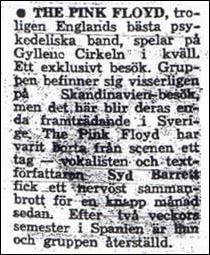 "The Pink Floyd, probably England's best psychedelic band, plays the Gyllene Cirkeln tonight..." - Aftonbladet September 10, 1967
|
Prior to the performance, the local press got to interview "England's best psychedelic band":
Syd Barrett: "No one will like what we play--it is just our lightshow that is mind-blowing."
Syd Barrett: "The name Pink Floyd comes from two blues singers from Georgia, USA--Pink Anderson and Floyd Council."
Roger Waters: "It just sounds like a nice name to us. It's really just a registration mark. It's better than calling ourselves 'CC338' or something like that."
Rick Wright: "We hope to be able to come back to Scandinavia on a bigger tour--to play for a bigger audience."
Well, I suppose Rick was right on that one. The impromptu nature of the gig and the corresponding lack of promotion resulted in a poor turn out, and only 275 people saw them play that night in Stockholm. But that didn't stop the band from taking their 7000 kroner fee (about 400 or 500 pounds) and getting out quick.
After the one-nighter in Stockholm, they drove all the way back to Denmark to do three nights at the Star Club restaurant in Copenhagen (September 11, 12, and 13). It was here in Zealand that things got ugly for Mr. Wright. (Things got really ugly for Rick and Dave Harris in "Zee"-land too, but that's another story.)
Near the end of a rather restrained press conference after one of the Star Club gigs, the band expressed their hunger and their desire to go out and get something to eat. Seizing the opportunity, some press people from BÝrge (a Danish weekly magazine for teenage boys) invited Pink Floyd out for some food and some entertainment on the town.
Probably exhausted from the week's grueling travel, Peter Wilson excused himself back to the hotel for some much-needed rest. So the four Floyds, plus Andrew King and three people form BÝrge (a writer, a photographer, and a fashion editor) set out for that most natural and typical Copenhagen destination: Tivoli.
 The main entrance into Tivoli.
|
Simply put, Tivoli is an amusement park; but there's more to it than that. Tivoli dates back to 1843 when Copenhagen was still a fortified city with high ramparts and a moat. With the King's permission, Georg Carstensen (1812-57) built his pleasure garden outside the city adjacent to the moat.
Besides the beautiful gardens, the original Tivoli consisted of a concert hall, a theater for dance and plays, a bazaar, swings, merry-go-rounds and other rides, skittle, billiards and other games, a restaurant and coffee houses. Today, Tivoli offers the same sort of attractions. The big difference being the ramparts of the city are gone, and a portion of the moat is now a lake within the expanded Tivoli boundary.
Everyone was in a delightful mood on their way into Tivoli--the five band members and the representatives from BÝrge too. As far as BÝrge was concerned, Pink Floyd was a five-member band. Andrew King was treated just like one of them.
The trouble started at the front gate. Initially, the group was unable to gain admission into the garden. "Get out! We don't want to see you longhaired idiots," yelled the lady at the front desk.
Sten Lau, the BÝrge photographer, was at the end of the line. He struggled his way forward and paid the lady the sixteen-kroner admission fee. It seems the non-Danish-speaking English boys couldn't figure out how much it cost to get in.
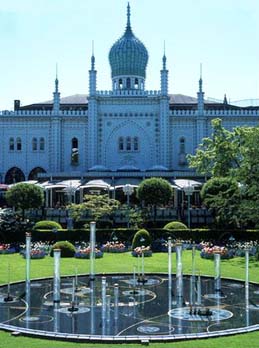 Tivoli's Nimb building, with the curious Bubble Fountain in front.
|
Once inside the park, Pink Floyd's eyes soon fell on the Bubble Fountain in front of the Nimb. Ever curious, they wanted to go inside and see how it worked. Within a few seconds of stepping on the grass, an officer and an elderly gentleman began verbally attacking the Floyds. "Can you come out? Get out of the garden. What do you think this is--a kindergarden?" A few expletives also went unregistered by the non-Danish-speaking band.
The entourage then strolled on through other parts of the amusement park. They tried the slides, the balloon-swing, the target-shooting range, and the radio-controlled cars.
They then ate a nice, (but expensive) meal at the Chinese tower restaurant. The filet of fish in champignon sauce was voted best all around.
So, you're at an amusement park, and you've just loaded up a full belly. What do you do next? You hit the roller coasters, right? Actually, the Floyd decided to try the "Blue Wagon" (a horror ride, of sorts) instead. With two riders to a wagon, four wagons went in, but only three wagons came out! There was panic in the control room, and the operator shut down the entire ride. The ride operator and the ticket-taker then disappeared into the building. After 20 minutes, Rick Wright and Andrew King finally appeared, looking pretty shaken.
It seems that Rick and Andrew had stopped inside the ride to examine some of its spooks more closely. But what they found was a swift kick in the pants. The ride operator hit Rick Wright so hard in the belly that he fell over. Andrew King received a punch in the face, and later remarked that his teeth ached from the blow. Rick and Andrew said, "We have no idea what happened. These people called at us in a language we couldn't understand, then they grabbed us and threw us out." As a final gesture, the British boys threw their cotton candy at them. "Let's give all the people--and the operaters--a cotton candy. Perhaps the nice lovely colour can make them happy."
And so ended Pink Floyd's visit to Tivoli. "Are all Danish so square that they don't understand when one is happy? Why are the Danish yelling and beating us up? Must one absolutely speak Danish to avoid getting beat up?"
The band went back to the Star Club to get a drink before heading home to the hotel. The disc jockey put the Pink Floyd's record on the gramophone. "Ah, it is lovely. At last something we can understand!"
 Syd, Nick, Roger, and Rick take a few shots at a Tivoli arcade booth, September 1967.
|
Show me where the 'keys' are kept
The many instruments of Rick Wright
Editor's Note: The following article details the various pianos, organs, and synthesizers that Rick Wright has used over the years, and is excerpted from an even longer (and more comprehensive) document that is constantly updated and refined. The full article--which includes many more photographs, an album-by-album list of each instrument used, and a section on samplers, sequencers, and other electronica--is available for download (PDF, 2.5MB).
Acoustic Pianos
The acoustic piano has always been an element of the Floyd's sound, and--unlike other groups of the time--Wright insisted on carrying acoustic pianos (although not always grand pianos) on tour throughout the '70s, as opposed to replacing the piano parts with an electric piano. It is difficult to say which make of piano is featured on each album. It has been suggested that there are many different makes used by Wright through the years, but there seem to be a couple of favorite brands: Steinway & Sons and Yamaha. Piano parts on The Dark Side of the Moon were recorded with a classical Steinway & Sons baby grand piano, which can be seen in the Abbey Road studios during the 'documentary' sections of Live at Pompeii. The Pompeii live recordings also featured a Steinway Grand ("A Saucerful of Secrets"). Wright has also been a fan of Yamaha pianos and has used the Yamaha C-7 Acoustic Grand Piano for some of the early albums, and then for Animals and then The Wall.
From 1987 onwards, Wright has been using the Kurzweil K2000 digital sampler series for their sampled piano sound--as opposed to real pianos--when playing live. Piano samples were used in the 1987-89 and 1994 tours. Sampled piano was also used during the Division Bell sessions, although the two songs on the album in which piano was dominant subsequently had the parts replaced by real piano. "Marooned" was originally recorded with a K2000, and Gilmour's original demo of "High Hopes" was played on a sampler, but was replaced by a real piano played by Jon Carin. Wright performed the piano parts of "Wish You Were Here" on a K2000 for the band's induction to the Rock & Roll Hall of Fame. Rick's current grand piano in his home studio is a Steinway.
Electric Pianos
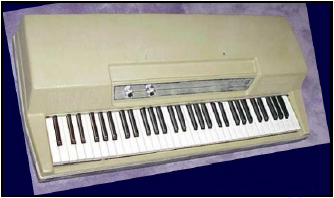 The vanilla-white Wurlitzer electric piano.
|
WURLITZER Electric Piano (1972-1975) Wright's use of the Wurlitzer piano is one of the defining elements in the Floyd sound. Rick used the EP-200 series model (vanilla white) in the studio, and a black EP-200A on tour. The funky vibe and tremolo of the 'Wurly' introduced an electric vibe that sat somewhere between the jazzy piano and the vibraphone--two of Wright's loves. The Wurlitzer was first used on Obscured by Clouds (1972), but the real showcase was in Dark Side (1973) and Wish You Were Here (1975); it is heard specifically in "Breathe", during the funky staccato counter-rhythm sections against Gilmour's guitar in "Time", in "Have a Cigar", and in the jazzy solo in "Shine On You Crazy Diamond" part 8. Wright used a wah-wah pedal to great effect in "Money", making it one of his more characteristic moments. The same treatment was also used in "What Do You Want From Me?" (1994), but Wright was either using his Rhodes (see below) or the sampled sound of his Kurzweil K2000 by then (as well as on tour).
FENDER RHODES Stage/Suitcase Electric Piano (1977-1981) The intro to "Sheep" (1977) is Wright's most obvious example of the 'Rhodes'. The Rhodes produces a 'jazzier' vibrating sound and is used mainly for leads and melodic passages, as opposed to the more rhythm-oriented Wurlitzer. While Wurlitzer was mainly used in Dark Side and Wish You Were Here, the Fender Rhodes was used in "Mudmen" from Obscured by Clouds, in Animals, and The Wall (in "Hey You", for example). Wright used a Rhodes Suitcase 73/88 Mark I for the studio and on the road, along with his favorite two Fender Twin Reverb amps. He has also used a Fender Rhodes Stage 73/88 Mark I.
Since 1987, a custom Kurzweil K2000 with 64Mb of RAM is used for samples of Rhodes and Wurlitzer Electric Pianos when the Floyd performed live, but Rick still has a Rhodes as part of his home studio, which was last used for the recordings of Broken China (1996). A Suitcase model was also used for Rick's guest appearance in Gilmour's 2002 concerts at the Royal Festival Hall.
The Rhodes sound has grown to become a Floyd trademark through the years, although it was, in fact, the sound of the '73-'75-era Wurlitzer that most people would be referring to, which is of course very similar to that of the Rhodes. Many would argue that some of the band's durability and the relative timelessness of their work can be attributed to this sound. Floyd were certainly pioneers and on the edge of technology up until a certain point in the seventies, and managed to formulate a 'trademark sound'; and sounds like that of the Rhodes, the Hammond, or the lush synth strings became staples of the 'Floyd sound'. So, in a way, bands like Pink Floyd that managed to sustain--if not increase--their popularity from generation to generation are largely responsible for the post-'90s revival and popularity of many 'vintage' instruments and sounds, including that of the Rhodes and Wurly, both of which have become staples in most trip-hop, funk, and electronica acts since the 1990s.
HOHNER CLAVINET D6 (1975-1978) The clavinet is a bass-type keyboard distinctive for its staccato sound and its quick attack and decay, and has been indelibly associated with funk. The riffs from Stevie Wonder's "Superstition" and Led Zeppelin's "Trampled Underfoot" are two well-known examples of the clavinet. The 'clavi' was not used very often by Wright, however he owned a D6 woodgrain model, and toured with it in '75 and '77. It is unmistakably featured in "Have a Cigar" for the rhythm bass line heard during the guitar solo, as well as in Part 8 of "Shine On You Crazy Diamond", where Wright plays the funky riff on top of Wurlizter chords, accompanied by VCS3 Synth effects. It is also (very discreetly) used in Animals. Although it is not easily verified just by listening to the album, a clavi is buried somewhere in the mix during the complex rhythm section of "Pigs (3 Different Ones)". Wright also used it in "Funky Deux", "Waves", and other tracks from Wet Dream (1978), his first solo album.
YAMAHA CP-70 Electric Grand Piano (1979-1981) The Yamaha CP-70 was prominently used in The Wall live shows, albeit not by Wright himself, but mostly by the late Pete Woods. On tour, the more 'straightforward' electric piano parts (i.e. where no Rhodes was used), were played on the CP-70, such as the extended solo passages like the ones played by Woods during live renditions of "Young Lust" and "Another Brick in the Wall, part 2".
Organs & Keyboards
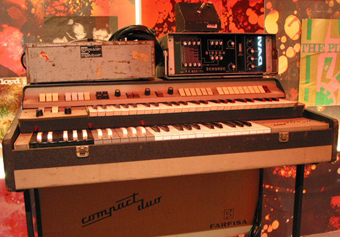 Wright's Farfisa Compact Duo Organ, as displayed at the Interstellar exhibition in Paris. Atop it at right are a Binson Echorec unit and the Azimuth Coordinator controller. (Photo by J. Evers.)
|
FARFISA organ (1965-1972) The Farfisa is a two-manual organ console. In comparison to the more popular Hammond organ (see below), the Farfisa produces a more 'classic' organ sound. Wright included a Binson Echorec device for echo as part of his combo and managed to produce many unusual sounds out of it, by experimenting with the Echorec and the organ's tone and pan settings. The Farfisa was Wright's main keyboard in the early years, when he was playing with Waters, Mason, Barrett, Klose, et al as The Sigma Six, The Screaming Abdabs, The T-Set, the Pink Floyd Sound, and so on. It was used almost exclusively up until The Piper at the Gates of Dawn in 1967. Between 1967 and 1972, the Farfisa organ played a crucial role in Floyd's sound and was used for many of Rick's leads, which he often panned around the auditorium using a special joystick (the 'Azimuth Coordinator' pot) stacked on top of the Echorec unit. Wright used the Farfisa for virtually every solo up until that point, including "The Embryo", "Fat Old Sun", and "Cymbaline". He can be seen playing one in Live at Pompeii (1972), and it was last used in the studio on The Dark Side of the Moon.
On stage, Floyd kept touring with a Farfisa as part of their equipment while they were still performing their pre-Dark Side set (e.g. "Careful With That Axe, Eugene", "Echoes", and "Set the Controls for the Heart of the Sun"). The Farfisa sound has been closely associated with certain tracks. In the final performance of "Eugene" (May 5, 1977), the Farfisa's absence really stands out to those who are familiar with the track's many live renditions. Wright used his Hammond and his array of Minimoog synthesizers (see below) to play that rendition, and the synth sound was somewhat alien to the piece. The organ in the intro of "time" is the last time the Farfisa was used in a Floyd recording.
 Wright's Hammond RT-3 organ, as displayed at the Interstellar exhibition in Paris.
|
HAMMOND organ (1967 to present) and LESLIE cabinet speakers The Hammond is a two-manual console (RT-3, B-3, C-3) or 'spinet' (M102) tonewheel organ. The Leslie cabinet is a speaker with rotary components which which gives the organ sound a very distinctive swirling effect (tremolo) that sets it apart from other organs, such as the Farfisa. Wright has used several different kinds of Hammonds and Leslies. He started with the M102 (1968-1972) that was featured in the early Floyd albums up until Obscured by Clouds. The RT-3 model (1972-1973) was used in the Dark Side of the Moon recording sessions and is also featured in Live at Pompeii during "A Saucerful of Secrets". The B-3 (1973-1974) and its twin sister, the C-3, were the most popular of all Hammond models and were used in every Floyd album from Dark Side onwards--depending on the recording studios. As for the Leslie cabinets, his most-commonly used Leslie model, since Dark Side, was Model 122. Prior to that, Wright had been using a Leslie cabinet Model 145 for Atom Heart Mother, Meddle, and Obscured by Clouds. Wright has used the Hammond in a variety of distinctive ways: for its 'aggressive swirl' overtones (e.g. "Mudmen", "Sheep"), as a basic organ layer on top of which other keyboard sounds (or Gilmour's guitar) were stacked (e.g. "Mudmen", "Shine On You Crazy Diamond", "Keep Talking").
With the gradual advent of synthesizes and other keyboards from 1972 onwards, the Hammond gradually became the dominant organ in Rick's gear, and eventually replaced the Farfisa altogether. Wright still uses the Hammonds to this day, and it has been the only 'vintage' keyboard he refused to substitute with latter-day samples, as its rotor sound and timbre simply cannot be accurately imitated. A B-3 was used in the 1987-89 and 1994 tours, and a Hammond/Suzuki XB-5 Digital Organ Emulator--a more recent digital incarnation of the portable classic--was used in the recording of Broken China and is now part of Wright's home studio gear.
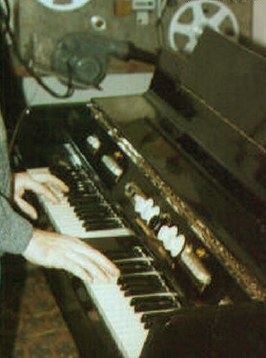 The Floyd's very own mellotron (photo taken while the instrument was being repaired at Streetly Electronics).
|
MELLOTRON (1968-1971) The Mellotron is a keyboard that is--loosely speaking--an early magnetic tape-operated 'sampler'. The Floyd owned a black Mellotron M400 Mark II (one of only 6 black models made) between 1968 and 1971, and used it exclusively in the studio. Floyd never gigged or toured with it and, after Atom Heart Mother, it was put into storage, where it ended up fairly badly damaged before being rescued, repaired, and subsequently sold.
Floyd's use of the 'Tron' has been sporadic, and unusual in that they did not always use it in a conventional and easily recognizable way--true to their 'experimental' label. Wright has used the flute tape set in early recordings, such as "Julia Dream", the studio version of "The Embryo", and in sections of "Atom Heart Mother" (most notably in the beginning of "Remergence"--the sound reminiscent of the intro of the Beatles' "Strawberry Fields"). Rick preferred to use the mellotron with ample reverb and effects that added depth and gave a slightly different dimension to the sounds, so some of the mellotron in Floyd recordings is not immediately apparent. The strings set has been used in the closing section ("Celestial Voices") of "A Saucerful of Secrets" (1968), in "Atom Heart Mother" (1970), and in "Sysyphus" (1969). Despite the suspicious resemblance of some of Rick's Farfisa 'pads' with mellotron strings in certain 1970-72 performances, "Careful With That Axe, Eugene" did not feature any mellotron. The Wright-penned single "It Would Be So Nice" (1968) also features a mellotron, as does "See-Saw" (1968). Recordings that have made use of choir tapes include Gilmour's "Narrow Way Part 2" and--most prominently--"Sysyphus" from Ummagumma (1969). Brass tapes and (speculatively) some other 'stranger' tape sets may have also been used in Ummagumma and the studio version of the "Syncopated Pandemonium" section of "A Saucerful of Secrets".
Another serious mellotron candidate--but subject of debate--is the 'trumpet' solo in "Summer '68" (1970). According to various sources, the lead is assumed to be produced by an 'early synthesizer', but there are sufficient reasons to discard this possibility. In a mid-'90s interview, Wright said that the first synthesizer he ever used was the VCS3 (see below). Although he is not renowned for his good memory about such facts, the track was recorded in July 1970 and the very few analogue (and monophonic) synths that existed then could not have possibly produced that timbre. Another (wild) guess was that the Floyd may have used the Moog synthesizer (probably available in the Abbey Road studios, left there from the Beatles' Abbey Road recording sessions), but this is again very unlikely. Cliff Jones' controversial book (subsequently withdrawn at Gilmour's own request, due to its many inaccuracies) suggests a fairly plausible (yet unconfirmed) scenario: that the Abbey Road Session Pops Orchestra (which had already played on the "Atom Heart Mother" Suite) also performed on "Summer '68". So for all we know the solo could have been a mellotron--perhaps EQ'ed slightly--although nobody has yet denied the possibility that the band may have used real brass instead.
Synthesizers
ELECTRONIC MUSIC STUDIOS (EMS) VOLTAGE CONTROLLED STUDIO Model 3 (VCS3) (1971) The band's association with their first ever synthesizer was established when Gilmour himself visited its inventor, Peter Zinovieff, in Zinovieff's laboratory in Putney, London. The VCS3 was a portable synthesizer with 3 voltage-controlled oscillators, a noise generator, a ring modulator, and other modules interconnected by means of a matrix patchboard. The oscillators generated sine waves, square waves, and saw-tooth wave signals, which could be programmed through the ring modulator or a series of the other filters in different combinations. The Synthi A (formerly Portabella) had the same specifications as the original VCS3, but was designed to fit in a an attached briefcase. So, technically, it is not accurate to credit the Synthi A as a 'VCS3', because the original VCS3 was actually an earlier model produced two years earlier (1969).
The VCS3/Synthi range was the British answer to the (American) Moog synthesizer, also used by Wright two years later. According to various sources (including the EMS archives), the VCS3 was used in the Meddle (1971) sessions, so it is almost certainly aVCS3 used in the middle ('Dr. Who') section of "One of These Days". (For the record, the BBC Recording Workshop did actually use the VCS3 for the original theme of the Dr. Who TV series). Another VCS3 'candidate' from Meddle could be the melody toward the crescendo in the final part of "Echoes". The Floyd's Synthi A offered a wide range of possibilities, but it took the band another year to discover what they could really do with it. They clearly liked the wind noises it produced, though!
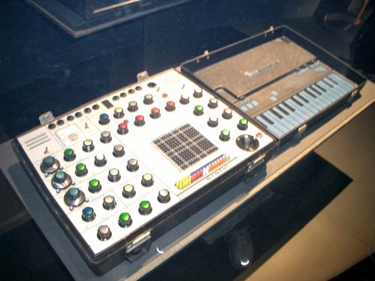 The modified VCS3 Synthi AKS that the Floyd use to this day (owned by Gilmour), as displayed at the Interstellar exhibition in Paris.
|
EMS VCS3 Synthesizer Model A Keyboard Sequencer (VCS3 Synthi AKS) (1972-present) A late 'suitcase' version of the VCS3 with attached sequencer and keyboard, the Synthi AKS had the same specifications as the Synthi A, but it also included a blue capacitive touch-sensitive miniature keyboard and an integrated sequencer. It was first used in the title track of Obscured by Clouds (1972), and also in "Free Four" for the single-note drone that accentuates the verses. The same single-note drone is also featured in the intro of "Time" (1973). Its first noteworthy use, and what set it apart from the earlier Synthi A model, came by experimenting with its integrated sequencer compartment to create the sequence for "On the Run" (originally laid down by Gilmour, and later replaced by Waters).
The Synthi AKS was also used as part of the layers in the orchestra-like intro of "Shine On You Crazy Diamond" Part 1 (where four separate VCS3 parts were recorded to form the four-note seventh chord) and the sweeping effects in "Shine On" parts 8 and 9, for the live versions of "Obscured by Clouds"/"When You're In", and for "Raving and Drooling" and "You Gotta Be Crazy". VCS3 was heavily featured in "Welcome to the Machine", and was used for various effects in Animals. It is a common misconception that the strict drum patterns heard in the intros of "Obscured by Clouds", "Childhood's End", and "Time" were simple 2-step octave sequences programmed with the VCS3, but in fact they were made by Waters' picking his Fender Precision Bass pickups. The Floyd kept the two VCS3 synths and used them concurrently in the studio by all of them except Mason. They carried the Synthi AKS (with the blue-lit keyboard) on the 1994 tour, and this instrument can be seen in action in the Dark Side of the Moon - Classic Albums DVD. Gilmour--not Wright--still keeps it in his studio to this day.
MOOG Minimoog Synthesizer (1973-1977) The Minimoog was the world's most popular analogue synthesizer at one point, so it was just a matter of time for the Floyd to get their hands on one. Wright used the Minimoog for many years mainly as a solo lead instrument on tour between 1973 and 1975, and it was his main synthesizer on Animals and the 1977 tour. By his own admission, Wright used the Moog for the first time on "Any Colour You Like" (1973) by overdubbing the echo-heavy synth leads. He started touring with a Minimoog in 1973 (the 1972 Dark Side shows did not feature a Minimoog). A Minimoog was also famously used for the synth 'horn' sound in "Shine On You Crazy Diamond", in addition to Moog Taurus Footpedals for bass drones during the complex introduction to "Shine On". A Minimoog was used for the main synth melody of "Have a Cigar" (1975) and in the live versions of "You Gotta Be Crazy" (1974-75) and "Dogs" (1977).
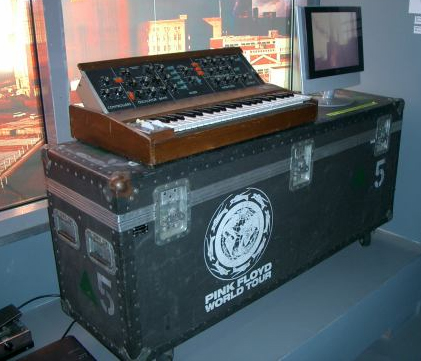 The Floyd's Minimoog synthesizer, as displayed at the Interstellar exhibition in Paris. |
There is some ambiguity as to which synth leads are played with a Minimoog and which with a VCS3. As a rule of thumb, the sweeping synth effects and drones are made with a VCS3, whereas most post-Dark Side leads are played with a Minimoog. Floyd's gear during the '77 tour included no fewer than three(!) Minimoog units. It is believed that the parts that were originally recorded with a VCS3 for the studio version of "Welcome to the Machine" were recreated with the Minimoog on the '77 tour, and that Rick did not actually carry a VCS3 on tour in 1977. Parts that featured the VCS3 (e.g. the intro of "Shine On" and the middle section of "Dogs") were played back by the front-of-house engineer, who triggered tapes (specially prepared from the multitrack recordings) that contained some synth layers and other noises and effects, so that Rick could play Hammond and Minimoog on top of them.
There is a certain amount of debate over the use of the Minimoog during the Wall recording sessions. The solo of "Run Like Hell" sounds like a Minimoog, but it is more likely that Wright used the polyphonic Prophet V instead. (The Prophet V was also an additive analogue synthesizer, capable of producing sounds similar to the Minimoog, but also capable of much more.) The distinctive Moog lead sounds were also used in later years for the solos of "Wearing the Inside Out" and "Keep Talking" (1994), which Wright performed with a Kurzweil K2000 sampler instead.
It has been suggested that a Moog synth may have been used for the recording of "The Narrow Way", but it is quite unlikely that the Floyd would have had access to one during April-June 1969. George Harrison had one especially made for him and used it on Abbey Road, which was recorded before August 1969, and Floyd were recording in 'next door', so in theory an engineer may well have 'allowed' Gilmour to use some of the equipment from Studio No. 2. On the other hand, it has been well documented that the Floyd only met the Beatles once, during 1967, and that Studio No. 2 was known as a Fab Four 'shrine', and hence not that much of a 'free access' area. Thus, it is rather unlikely that a Moog is featured in Ummagumma, and the fact that a 'Moog' was mentioned probably stems from its popularity later in the '70s rather than actual fact. However, the question remains: were the effects heard during "Narrow Way part 1" manipulated guitar effects? Was it indeed a Moog? Or did Abbey Road studios have access to an early VCS3 in 1969? The most likely explanation is that Gilmour fed his guitar signal through some of the studio's modulation/frequency-altering devices, thereby achieving similar effect without using a 'proper' synthesizer unit (yet--though he used an EMS Synthi Hi-Fli guitar synthesizer from 1973-1975).
ARP SOLINA STRING Ensemble / Odyssey / QUADRA Synthesizer (1972-1981) The ARP (an acronym for the company's founder, Alan R. Pearlman) synthesizer series became popular--especially in the US--primarily for fir string sounds. The 'Solina String Ensemble' (model IV), otherwise known as the 'String Synthesizer', was apparently first used during "Absolutely Curtains" (1972) and by Gilmour in the intro to "Childhood's End", though it was definitely not part of Rick's keyboard rig yet). The Solina String Ensemble model V was probably the first ARP synth to become a part of Wright's rig, from 1974-75 onwards, and it was unofficially dubbed as 'The Floyd's String Machine'. Other British artists started recording with an ARP in '75, including Mike Oldfield, whose album Ommadawn (1975) also featured the same string sound. Wright undoubtedly left a mark by using it for the high-string layers in "Shine On" and in all of the tracks on "Wish You Were Here", as well as on "Dogs" (backing the guitar harmony section), "Pigs", and "Sheep" (1977). The string sounds are also prominent in The Wall 1980-81 live shows, e.g. during the "Last Few Bricks" medley just before "Goodbye Cruel World". It is, however, a subsequent ARP model that was used in The Wall sessions (it is debated whether it was a Quadra or the more popular Odyssey--possibly a Mark III.)
Korg VC-10 / EMS Vocoder 5000 (1976-1977) / Roland VP-330 Plus Vocoder (1987) Although not a typical synthesizer as such, the vocoder is nonetheless a voice-synthesizing device, activated through voice input, to add a 'robotic' quality to vocals. Floyd first used a Vocoder in 1976 during the Animals sessions for Roger's lead vocals in "Pigs" and for the bastardised psalm on "Sheep", as well as for the treated barking sounds and other effects in "Dogs". Rick's keyboards were also fed through the Vocoder, notably during the middle sections of "Dogs". Although it is not documented which particular model was used in Britannia Row studios for the recording of Animals, it is reported that they used the now classic Korg VC-10 model. However, it may be possible (through the Floyd's established association with the UK-based EMS, and because of the 1976 production date of EMS' vocoder device) that Floyd might as well have used the EMS Studio Vocoder (also known as the Vocoder 5000). Another Vocoder device was also used, ten years later, for the recording of "A New Machine" (1987), presumably the then-popular Roland VP-330 moel. It was Waters and Gilmour who mainly operated the Vocoder device--not Wright. Yet Wright's vocoder-processed keyboards on "Dogs" had a most chilling effect and have become a classic Floyd moment.
YAMAHA GX1 Polyphonic Synthesizer (late 1970s?) The GX1 (also known as the GX-1--with a hyphen) was a polyphonic synth with the distinction of being extremely rare among the synthesizer community. Wright is mentioned in various sources as having owned a GX1 (presumably for a brief period of time) but it is not clear when that was. It had an official production date of 1975, so Wright may have actually used it before the (also polyphonic) Oberheim. The GX1 was a legendary machine that looked more like a silver space-age cathedral organ and offered features unheard of at the time: it was polyphonic, multitimbral, and had multiple (3) keyboards, nearly every note was duophonic, offered patch storage, and even had a primitive beat box. Its 'tone cartridge' architecture and sound synthesis were (and still are) unique, which added to the fact that it was not at all straightforward to program and operate. It was developed by Yamaha as a test bed for later consumer synths (the CS50, CS60, and CS80 were its descendants), so only about 50 were produced and few of them actually left Japan. ABBA's Benny Andersson had one, Stevie Wonder had two, and Keith Emerson had at least two, one of which he bought from Led Zeppelin's John Paul Jones and one recently sold to Hans Zimmer. If, indeed, Rick ever used one, it was probably a transitional instrument before he switched to the other cheaper and lighter polyphonic synths. The GX1 weighed nearly a ton and was incredibly fragile, so a likely assumption is that Rick could not cope with the logistics of storing and handling it, let alone touring with it (although ELP famously did). Overall, the GX1 was a technically outstanding and highly expressive instrument that came very close to simulating the nuances of an acoustic instrument--impressive even by today's standards. It is remarkable, then, that there are no known recordings of the GX1 in the Floyd (or Wright's solo) canon, despite Wright's name persistently appearing in the lists of those who have owned one.
OBERHEIM FOUR-VOICE Polyphonic Synthesizer (1977-1978?) It is certain that Wright used an Oberheim synthesizer, but not which model exactly; and this was probably the 4-Voice, the first polyphonic synthesizer to be announced at the time--along with Moog's Polysynth. All of the synthesizers mentioned above (except the GX1) were monophonic, i.e. capable of producing only once note at a time. It is possible that an Oberheim was part of the equipment in Floyd's Britannia Row Studios, where both Animals (1977) and Wet Dream (1978) were recorded, but it was almost certainly not used in Animals at all. The credits of Wet Dream mention "Oberheim synthesizer", so it is safe to assume that Rick got his hands on one circa 1977-78. The familiar synth horn lead in "Mediterranean C" is played with the Oberheim, harking back to the brass melody of "Atom Heart Mother" and "Summer '68", a sound he would try again, in 1994, for "Wearing the Inside Out". Rick probably did not use the Oberheim for too long, favouring the superior Prophet V, which appeared a year later.
SEQUENTIAL CIRCUITS (SCI) PROPHET V Polyphonic Synthesizer (1979-1981) Wright acquired this polyphonic synthesizer when it first came out and used it for The Wall sessions and live shows. Prophet V was the first full-programmable analogue synth that offered unsurpassed polyphony, could play multi-sounds and effects with echoes and repeats, and had extremely flexible analogue filters, envelopes, and LFOs. The Prophet quickly became the de facto '80s analogue classic, inevitably favored by synth pioneers and later synth pop bands alike. Even now, Wright refers to the Prophet as his 'favorite synth'. This poses a bit of an argument regarding the debate about how much of the keyboards/synthesizers heard in The Wall (which was--by Floyd standards--not that much anyway) were actually played by Wright, as opposed to session musicians.
The keyboard /synth credits for The Wall been a very 'sticky' issue, indeed. Through the years, it has been assumed that most of the keyboard duties were not handled by Wright, but by Bob Ezrin, Pete Woods, Fredie Mandell, and Michael Kamen (even Gilmour claims to have played some). But this might be a slight exaggeration, for all we know. It is generally accepted that Rick did not 'pull his weight' during the recordings. However, it is known that Wright did play keyboards up until the point that Roger made it clear that neither Wright nor Mason would be receive a production credit. Once Ezrin was established as the arbiter of the sessions, Wright lost interest and was ousted from the band after the summer of '79. Therefore, several keyboard parts were left unfinished, including parts for songs that were written late in the recording process (e.g. "Nobody Home"). Just the same, James Guthrie, who co-produced and engineered the sessions, has said that 'Rick did some great playing on that album, whether or not people remember it--some fantastic Hammond parts'. It would be fair to say that Wright did contribute up to a certain point in the album's development.
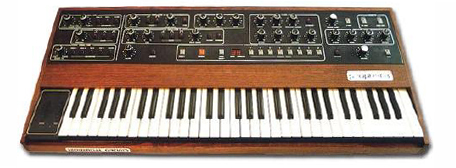 Rick's favorite synthesizer--the SCI Prophet V.
|
Generally speaking, the keyboards on The Wall assumed a role very different to that of previous Floyd albums. There was a lot of material, and the tracks had to be 'tighter', so there was not much space for extended instrumental meanderings and solos. The overall production (heavily influenced by seasoned hard-rock producer Ezrin) called for guitars that were harder and full of delay and flanger, and keyboard parts that suited the mock-heavy rock style of tracks like "In the Flesh", "Young Lust", "and Waiting for the Worms"--'rock organ'-type Hammond parts, and piano that was quite different from Rick's usual jazzy style. Several sections were carefully orchestrated and had to be precise, something that Rick (a fan of improvisation and not the most competent pianist) could never really cope with, whereas session keyboardists could--on demand and on the spot, exactly the way Waters and Ezrin would like.
Synthesizers on The Wall were relatively subdued and nowhere near as prominent as in previous albums. They were used to add a certain 'edge' in places (e.g. the piano-complementing synth sweeps in "The Thin Ice", or the background synths in "Goodbye Blue Sky"), provide atmospheric 'embellishments' (like the unmistakably "Sheep"-reminiscing passages of "Don't Leave Me Now" or the synth in "Is There Anybody Out There?"), and to complement some orchestral parts. All in all, a far cry from the band's adventurous keyboard arrangements. So, assuming that several of Rick's Hammond parts were actually used, surely he played some of the synth parts, too. Otherwise, why would Rick say that the Prophet was his favorite synth? The synth solo in "Run Like Hell" is one of very few prominent synthesizer moments on the album, along with the intro of "Empty Spaces" and the ending chords of "Another Brick in the Wall, part 1", and all were most likely played by Rick. The remaining keyboard parts and overdubs were, indeed, played by others. Most--if not all--piano parts were played by Pete Woods and Michael Kamen. Woods also played electric piano, some Hammond parts (e.g. "In the Flesh", "One of My Turns") were played by Freddie Mandell, and the synthesizer overdubs were probably handled by Ezrin, a keen keyboardist in his own right.
As soon as The Wall shows came to an end, Wright went sailing in the Greek isles. With the exception of his brief involvement with the Fairlight as part of the ill-fated Zee duo in 1984, Wright missed out on most of the synthesizer development on the 1980s, until his lukewarm 'comeback' in 1987.
ROLAND Super JX (JX-10) Analogue/Digital Synthesizer (1986-1989) This Roland synth was a popular digital/analogue hybrid model It was used on A Momentary Lapse of Reason by Jon Carin, Pat Leonard, Bob Ezrin, et al. It has to be said that--despite it's being one of the most acclaimed synths of its time--the Super JX did not, in hindsight, suit the band's sound at all. The keyboards on the 1987-89 tour were perhaps appropriate for the new material, but definitely did not do justice to older tracks such as "Echoes", "Welcome to the Machine", or even the staple "Shine On You Crazy Diamond". Unfortunately, Wright, Carin, and the late-80s touring technicians fell into the trap of 'modernising' their synth gear, which resulted in an '80s-sounding' sound that has dated quite badly. Wright and Carin used the Super JX in the 1987-89 tour, until the Floyd decided to switch exclusively to Kurzweil synths/samplers. For the 1994 tour, keyboard technician Andy Ledbetter took great care to program the Kurzweil series so that the band's vintage synth sounds could be faithfully reproduced, despite being playing by digital samplers. Jon Carin, the band's other tour keyboardist, should also be given some credit for this, as he demonstrated on the Floyd's 1994 tour and in Roger Waters' 1999-2002 tours. The synth textures on Waters' tour were extremely faithful to the vintage sounds--perhaps even more than on p.u.l.s.e (1995)--with "Shine On" and "Dogs" being two cases in point.
KURZWEIL K250 / K1000 Sampler/Synthesizer (1986-1988?) The specifics of the synth equipment used on the Momentary Lapse of Reason sessions are a bit hazy. With the exception of the Super JX, Floyd (i.e. Gilmour, Ezrin , Leonard, and Carin, rather than Wright) also used a 'Kurzweil', and they even explicitly mentioned it on the credits (something unheard of since the explicit mention of the VCS3 on the Dark Side sleeve). Wright had very little involvement in the recording, joining Gilmour and Mason toward the end of the sessions, so he mostly played Hammond parts and piano on a few tracks ("On the Turning Away", "Terminal Frost", and "Sorrow"). It is also likely that the 'Kurzweil' used on Momentary Lapse was a K250 and not a model of the K1000 series that was also available at the time.
As a trivia sidenote, the Kurzweeil series came with a built-in PINKFLYD program as a preset, which used 31 layers and almost every single parameter available to simulate "On the Run". All of the sequence was created by means of triangle waves, square waves, and white noise, and was programming by Daniel Fisher (who was employed by Kurzweil as a result!). This was later demonstrated to the Floyd, who were sufficiently impressed to consider using it on the road, and switched to Kurzweil synths and samplers exclusively. To their own (and the audience's) amusement, during the 'performance' of "On the Run" in 1987-89, the band blatantly left the Kurzweil playing the sequence on its own (with a red spotlight on it) while they disappeared from stage.
KURZWEIL K2000 / K2000RS & K2000VP Digital Synthesizer (1993 to present) The first all-digital synthesizers used by Wright and Carin on the Division Bell and the 1994 tour, marking the point from which Wright and Carin fully embraced digital samplers/synthesizers. The K2000 was used in the studio. For the tour, Floyd's rig also included the Kurweil MIDIboard MIDI controller, the K2000RS rack units and the K2000VP. The Kurzweil K2000 series was also used by Rick on Broken China, along with the MIDIBoard, an AKAI S1100 sampler, and an E-mu Proteus Orchestral Sample Playback Unit (for samples of strings, cello, and other orchestral instruments) as part of his rig. Wright also used a K2000 for the sampled acoustic piano sound when he performed "Wish You Were Here" at Pink Floyd's induction into the Rock & Roll Hall of Fame in 1996. Rick seems to have settled on Kurzweil Synths, a notion that is reinforced by the fact that Wright, Carin, and percussionist Gary Wallis appeared on a Kurzweil magazine advertisement in the mid-1990s.
Other Assorted Instruments
This article focuses primarily on keyboards and synthesizers, and as such this section serves only as a brief overview of some of the other instruments Wright used during his first years with the Floyd. Most of these have only been used on a handful of occasions during recordings and gigs.
CELESTE (1967-1969) Wright has played celeste on a few occasions, including "The Gnome" (1967), and probably the studio recording of "A Saucerful of Secrets" (1968), "Quicksilver" (1969), and "Sysyphus (1969).
PENNY WHISTLE and KAZOO (1968) According to several sources, Rick played the penny whistle heard during "Jugband Blues" (1968), during the middle section featuring the Salvation Army Band of North London on brass. Other members also played some unusual instruments, most notably Nick Mason, who opted for a remarkably cacophonous performance on kazoo. Whether it was Mason, Wright, Barrett, or Waters playing the kazoo melody in "Corporal Clegg" remains unknown.
VIBRAPHONE (1968-1970) The vibraphone has been used in "Set the Controls for the Heart of the Sun" and "A Saucerful of Secrets" (1968), the studio recording of "Careful With That Axe, Eugene" (1968), "The Crying Song" and "Quicksilver" from More (1969), and "Sysyphus" from Ummagumma (1969). It was also a part of their touring equipment during 1969-70, as can be seen on the back cover of Ummagumma, and was featured on several parts of The Man and The Journey suite (1969-70), including "Sleep". In the early '70s, Wright started relying solely relying on the 'vibe' sound produced by his Rhodes and Wurlitzer electric pianos.
GONG (1968-1972) The gong was a part of the Floyd's live equipment since the early days, and was mostly (and infamously) used by Waters (during "A Saucerful of Secrets" and "Set the Controls"). Rick (ab)used the band's gong for "Sysyphus", along with other cymbals, tympani, snare drum, and even Gilmour's slide guitar.
TROMBONE (1969-1970) Rick played the trombone in the studio recording of "Biding My Time" (1969) and in its live renditions during "Afternoon" (from The Man and The Journey in 1969 and 1970.
HARMONIUM (1970-1972 & 1982) The harmonium is a keyboard-based organ, with a small (usually three to four octaves) kayboard and knobs (usually three to seven), that also features something like an air 'pump', not unlike an accordion. It has been written that Rick played a harmonium during the 1970 sessions for Syd Barrett's solo albums The Madcap Laughs and Barrett. It has also been suggested that Rick used a harmonium in Obscured by Clouds, with the most likely tracks being "Mudmen" and "Absolutely Curtains". However, this is subject to debate. For example, in the section of "Mudmen" during the pedal steel guitar solo it is possible that Rick patched his Farfisa organ through a VCS3 to alter the sound's decay and produced that wah-like effect. (Michael Kamen played harmonium on the Wright-less Final Cut.)
In my head is a picture
How one fan helped a photographer recover a bit of lost Floydian history
We all know Vic Singh as the photographer behind the camera for the famed Piper at the Gates of Dawn cover shoot. This article tells the story of how I managed to help Vic recover one of his long-lost photographs from that session.
It all started with this photograph:
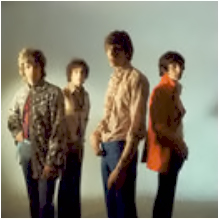 Pink Floyd, 1967.
|
Who took this photo? When and where was it taken?
I know I'm crazy. Asking such questions is crazy talk. But I'm a big fan. And crazy stuff is what fanatics do.
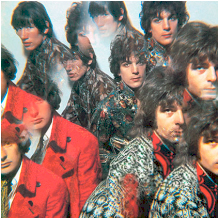 The Piper at the Gates of Dawn cover photo.
|
1967 was a very busy year for Pink Floyd in front of the camera. Dozens and dozens of photo sessions taken all over the place. Every Tom, Dick, and Harry music rag had there own photo sessions with the band. As a new band with dreams of being "pop stars", they relished such activity. And EMI was also heavily promoting the band. This constant coverage of the band's activities is just one of many reasons that 1967 is one of the most interesting years in the band's history.
A couple years ago, as part of a larger project, I started collecting, sorting, organizing and attempting to identify every Floydian mug shot taken during that magical year. It's a daunting task, with little hard evidence to go on. Often, picture identification begins by asking "What are they wearing?" and then comparing that to other photos that you do know something about. Like Vic Singh's famous photo.
As you can see when comparing the Piper cover with the first picture, Nick and Rick are wearing the same thing. Syd and Roger are wearing something different. As such, I initially classified the first picture as not being one of Vic's.
But that conclusion got less certain after I purchased a September 1967 edition of Rave magazine. That magazine published the following outtake from Vic's session:
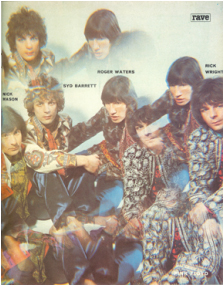 A Piper cover outtake, published in Rave magazine in 1967.
|
Syd has changed clothes! He now is wearing the same thing as in the first 'unknown' photograph, leaving only Roger as being different. If Syd had changed closes, could Roger have done so too?
Also about the same time I discovered this picture in Rave, I read an article by Vic Singh regarding his session with Pink Floyd. In this article, Vic basically stated that the band had a lot of fun trying on a box full of rented brightly colored clothing they had brought to the studio. Vic had instructed them to do so, since the prism lens he used tended to dull the colors in the resulting image.
Now, all things were possible. So via my friend John Cavanagh, I managed to contact Mr. Singh and ask him some questions about his famous photo session with the band and whether or not the photograph at the beginning of this article was one of his.
Ed Paule: Is the attached photo an outtake from your Piper cover shoot?
Vic Singh: I've had a good look. Firstly, the ages of the band look right. Second, I remember the band hired a lot of 60s clothes for the Piper shoot which look familiar, especially the red jacket stands out as the one on the Piper cover. Fourth, I shot all the photos on a white background that can also come out greyish depending on the lighting. And finally, I shot the photos over a whole day, so we must have covered the session with a change of clothes and a few different positions taken without the prism lens for P.R., etc. Also the clothes were borrowed or rented for the Piper session so it's pretty slim that they were used by another photographer. I'm pretty sure now that it is my photo. However, it was such a long time ago. It gets hard to remember; but thanks for sending the photo. It would be great if I could find an original print or high resolution scan of this photo to include in a Pink Floyd Photo Exhibition at the Redfern Gallery that I am participating in which starts in February 2006. If you could help me, it would be great.
[Did Vic Singh just ask me for help in finding one of his own pictures???]
EP: The photograph in question was once used on the cover of MOJO. In the magazine, they attribute the photo to Rex Features. Perhaps they can help you.
VS: I have known Rex Features for years. They are one of the oldest news photo syndication agencies and sell hundreds of photographers' images. They also have some of my photos in their stock. I'm going to try and find out the name of the photographer who took the magazine cover photo.
Later, I asked Vic:
EP: Any luck finding the photographer for the MOJO cover pic in question? On Rex Features' website, they use the initials "DZ" to identify the photographer. As such, I believe the person in question is Dezo Hoffman. What do you think?
EP: Any luck finding the photographer for the MOJO cover pic in question? On Rex Features' website, they use the initials "DZ" to identify the photographer. As such, I believe the person in question is Dezo Hoffman. What do you think?
VS: I got a reply from Rex a couple of days ago; they took their time.
Rex Features: "I have now confirmed that the image on the cover of MOJO is one of Dezo's."
Rex Features: "I have now confirmed that the image on the cover of MOJO is one of Dezo's."
[So the photo that started it all is not one of Vic's after all.]
EP: Exactly when and where did your photo shoot with Pink Floyd occur?
VS: 1967 in my Studio. Vic Singh Ltd. 7 Bourdon Place, Mayfair, London W.1.
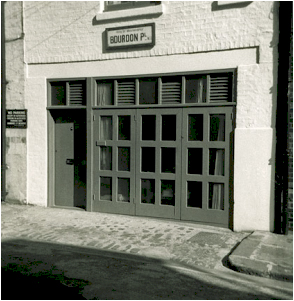 Vic Singh's 1967 studio.
|
EP: I was hoping that you had somehow managed to maintain after all these years some of the negatives, prints, or contact sheets from your session. So that the answer to my initial question would be something like, "Yeah I took that shot. It's the fourth pic on the third roll...." Having you in turn ask me for prints or scans tells me that I was hoping for too much.
VS: I closed my studio in '68 or '69 and went to live in the country. I left most of my negatives in my mum's storeroom in Regents Park. She moved flats and my negs got lost, about 90% of my material. A great shame, but these things happen. All I can say is that in the millions of photos circulating, my photos are pretty rare. As you may have noticed, I have only one photo for sale on my site for over a year. Fate has taken me down this road and I don't mind; one good image is better than a million average ones.
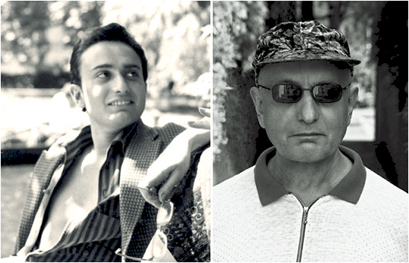 Vic Singh, then and now.
|
EP: How did you meet the band? How did you come to get chosen for their album cover photo shoot?
VS: At the time of the shoot, I was a busy photographer working for the fashion, advertising, and music industries. The Pink Floyd were a new and unknown band. I met them at an event at Piccadilly Circus and they seemed pretty far out. Soon after, they got in touch and asked could I shoot a cover photo? I agreed and asked them what they wanted on the cover, they left it to me as they had no image of the band. So I asked them to get some groovy clothes and shot them on a plain white background with a prism lens that George Harrison had given me. They loved the photo. Syd created the back of the sleeve and the rest is history.
EP: Have you ever seen the September 1967 edition of Rave magazine? One of your pictures was published inside (full page too)!
VS: No I haven't. Any chance of getting a copy or scan?
[So I sent Vic some scans. Not just the Rave photo, but all the outtakes I knew about. As a result, Vic soon purchased his own copy of Barry Miles' Visual Documentary book and the CD version of Piper at the Gates of Dawn. One of Vic's photos was used in the CD's booklet.]
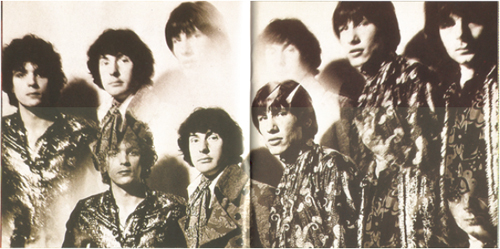 A spread from the Piper CD booklet.
|
EP: Did you select the cover photo yourself? Or did you select several candidate photos and then let the band pick the one they liked?
VS: They had most of the color transparencies and selected the photos themselves.
EP: What materials did you supply to EMI? Did they get just the selected cover photo? Or did they get copies of all your negatives? Or somewhere in between? Perhaps EMI can help you recover some of your lost photos.
VS: I shot the photos on a Hasselblad (two-and-a-quarter inch square) transparency colour Kodak Ektachrome film. The band's manager got all the transparencies. What he gave to EMI, I don't know.
EP: And the clothes? You stated that you thought that they "borrowed or rented" the clothes for the shoot. In my research, I've seen many of the same clothes appear in many other photo shoots. As such, I believe they "owned" the clothes themselves. I've dated some of these other photo shoots to as early as April 1967. Thus, if your photo session occurred in May, June, or July, the evidence suggests that they brought with them clothes they already owned. But, if your photo session was in March or April, they could have brought rented clothes with them... which they could have liked so much that they decided to buy them afterwards.
VS: I can't exactly remember in which month I did the session. It could well have been around March or April-ish. I remember explaining to them that the prism lens tended to soften the image because bodies merged into one another, so they were to get some bright, psychedelic-coloured clothes to add contrast. The clothes were also in fashion at the time, so it all gelled up. They could have well liked my Piper photo and bought the clothes for other uses.
VS: It would be great to have some high resolution photos which I could possibly add to the exhibition at the Redfern Gallery. There may be just enough time. I'm going to scan the images from Miles' book and the Piper CD on my high-res scanner with the de-screening filter 'on' which takes out the moire effect, these are the lines from screen printing in magazines or record covers, etc. Hopefully I should be able to get fine art Giclee prints off these. This leaves the photo from Rave which is pretty rare and I would love to be able to reproduce it as a fine art print. So I'm going to ask you for a favor...
EP: Sure thing. My scanner isn't that good, so I'll mail my Rave magazine to you so that you can scan it yourself.
VS: Thanks, Ed; you have been a gem.
EP: You are too kind. In the meantime, how are those other leads coming along with trying find more of your missing photos? Was my friend David Parker was able to put you in touch with Andrew King, Pink Floyd's old manager?
VS: No. No contact with Andrew King.
EP: David also mentioned that the photograph used in the CD booklet of Piper probably came from Storm Thorgerson. Any luck contacting Storm?
VS: I sent Storm an e-mail some time ago regarding Piper photos, but as of yet have received no reply. I also rang Barry Miles, but he was unhelpful and just said he had no images from the Piper shoot.
Well, that about wraps it up. Vic received my Rave magazine. He made a super high resolution scan, edited out the lettering and did a bit of digital retouching. The end result turned out quite nice. Fine art giclee (pronounced gee-clay) prints are now available for sale online and at the Redfern Gallery.
Vic has kindly sent me two autographed giclees of his "new" photograph. One is a 'thank you' to me, which will soon be framed and hanging on my wall. The other is a 'thank you' to all the Pink Floyd fans for all their support. Spare Bricks is sponsoring a drawing to win this valuable collector's item.
